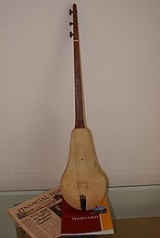ishimomura
In an Edo period literature called Geiennisshou 秇苑日渉(1807), there are comprised eight names for musical instruments referred to in a chronicle of the Mongolic dynasty known as 元史(1369). They are 渾不似,胡不兒,火不思,虎拍子,琥珀思,胡撥四,呉撥四. Based on Tang dynasty phonology (唐代音韻), the second name 胡不兒 can be read as /γobur/. In Bulghar Turkic, the morpheme {r} functions as a plural marker. The ending 兒/r/ contrasts with the four endings 似,思,子,四, whose phonetic value of the period of Tang dynasty is /s/. Its voiced counterpart /z/ is also a plural marker in General Turkic. The alternation between /s/ and /z/ sounds is not a rare phenomenon in loan words. Therefore, kobuz and its phonetic variants may be decomposed into the two components, \*kobu- (noun) and -z/-r (plural marker).


